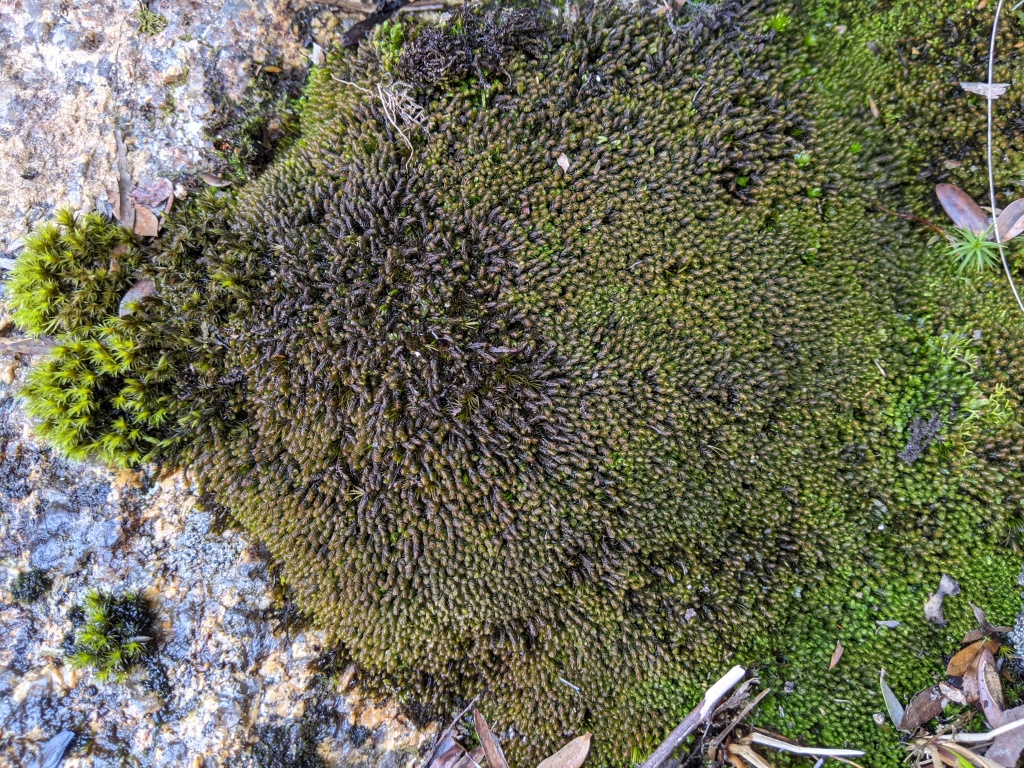Syzygiella
Terrestrial or lithophytic, dioicous. Asexual reproduction rarely by caducous leaves (not in Victoria). Stems prostrate (not in Victoria) to erect, sometimes differentiated into leafless creeping axes and erect or ascending leafy axes, sparingly and irregularly branched; branches emerging laterally or ventrally from stems and with a collar of tissue at base, or near abaxial side of narrower lateral leaf and without a collar of tissue at base. Lateral leaves lingulate (not in Victoria), oblong, lanceolate (not in Victoria), or ovate to orbicular, unlobed or rarely bilobed (not in Victoria), opposite (not in Victoria) or alternate, sometimes fused, distant (not in Victoria) to imbricate, succubous, widely spreading from the stem or erect and appressed to the stem (not in Victoria) or adjacent leaves, entire or rarely denticulate, sometimes erose, sometimes undulate, recurved, revolute or plane, acute (not in Victoria) or rounded at apex, rarely emarginate (not in Victoria); lobes when present (not in Victoria) triangular, equal or unequal, rounded to acute. Underleaves absent, vestigial and fused with lateral leaf base, or rarely distinct (not in Victoria) and filiform to narrowly lingulate or lanceolate, or bifid with triangular lobes (not in Victoria). Leaf cells quadrate, circular or irregular to polygonal, sometimes becoming oblong to rectangular at base, smooth to verrucose (not in Victoria) or papillose, thin- or firm-walled, rarely becoming thinner-walled and hyaline along margin, or sometimes becoming thicker-walled toward margin, with distinct trigones or without trigones, with 5–20 oil bodies; oil bodies spherical to ovoid or ellipsoid, finely granular-botryoidal. Rhizoids lacking or few and in fascicles from lateral leaf bases (not in Victoria) or scattered near bases on leafy stems and along leafless creeping stems. Androecia intercalary on long leafy axes, with 3–10 pairs of leaf-like, ventricose or rarely dentate (not in Victoria) bracts, each with 1–3 antheridia. Sporophytes terminal on long leafy axes, developing within highly differentiated bracts and perianth; bracts smaller than leaves, sheathing at base, usually lobulate, lobed or more dentate than leaves; perianth ellipsoid, ovoid or cylindric, emergent beyond bracts, sometimes twisted, becoming pluriplicate toward mouth where entire to ciliate; capsule ovoid to ellipsoid, 2–8-stratose; elaters 1–3-spiral; spores tuberculate, verrucose or granulate.
Thirty-five species shared between southern temperate and Subantarctic regions, East Africa, Madagascar and the Mascarene Islands, south-east Asia through to the tropical Pacific, and South to Central America (Schuster 2002, 2021; Söderström et al. 2016); four species in Victoria. .
The former Victorian genera Cryptochila R.M.Schust. and Jamesoniella (Spruce) F.Lees are now included within Syzygiella (Söderström et al. 2016). Jamesoniella and species of the former narrower circumscription of Syzygiella each belonged to several separate lineages in chloroplast and nuclear DNA phylogenies, rather than all species from each of these genera forming their own exclusive groups i.e. both genera in their former circumscriptions were polyphyletic (Feldberg et al. 2010). Cryptochila was also placed between the multiple Jamesoniella and Syzygiella lineages and so is subsumed into Syzygiella.
Feldberg, K., Váňa, J., Long, D.G., Shaw, A.J., Hentschel, J. & Heinrichs, J. (2010). A phylogeny of Adelanthaceae (Jungermanniales, Marchantiophyta) based on nuclear and chloroplast DNA markers, with comments on classification, cryptic speciation and biogeography. Molecular Phylogenetics and Evolution 55: 293–304.
Schuster, R.M. (2002). Austral Hepaticae Part II. Nova Hedwigia Beiheft 119. Cramer in der Gebrüder Borntraeger Verlagsbuchbehandlung: Berling & Stuttgart.
Schuster, R.M. (2021). Austral Hepaticae Part III. Nova Hedwigia Beiheft 120. Cramer in der Gebrüder Borntraeger Verlagsbuchbehandlung: Stuttgart.
Söderström, L., Hagborg, A., von Konrat, M., Bartholomew-Began, S., Bell, D., Briscoe, L., Brown, E., Cargill, D.C., Costa, D.P., Crandall-Stotler, B.J., Cooper, E.D., Dauphin, G., Engel, J.J., Feldberg, K., Glenny, D., Gradstein, S.R., He, X., Heinrichs, J., Hentschel, J., Ilkiu-Borges, A.L., Katagiri, T., Konstantinova, N.A., Larraín, J., Long, D.G., Nebel, M., Pócs, T., Puche, F., Reiner-Drehwald, E., Renner, M.A.M., Sass-Gyarmati, A., Schäfer-Verwimp, A., Moragues, J.S., Stotler, R.E., Sukkharak, P., Thiers, B.M., Uribe, J., Váňa, J., Villarreal, J.C., Wigginton, M., Zhang, L. & Zhu, R. (2016). World checklist of hornworts and liverworts. Phytokeys 59: 1–828.
 Spinning
Spinning